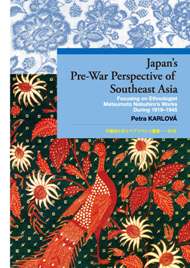
ホーム > English Titles, 新刊案内, 早稲田大学エウプラクシス叢書, 歴史・哲学 > Japan’s Pre-War Perspective of
Southeast Asia
 |
The established theory argues that pre-war Japan’s perspective of Southeast Asia was mainly concerned with its natural resources. However, this book on ethnologist Matsumoto Nobuhiro shows that scientific study of Southeast Asian culture had already existed in this time. It traces the formation and development of Matsumoto’s ideas on Southeast Asia based on his writings in the period 1919-1945. Matsumoto started studying this region from evolutionist ethnology and decided to focus on it under the influence of diffusionist ethnology, because he believed in significance of Japan's relation with Southeast Asia in ancient times. In the 1930s and 1940s, he established Southeast Asian studies and Vietnamese studies by bringing research materials from French Indochina to Japan, introducing them to the Japanese people and founding research institutes at Keio University. He acquired various theories from Western and Japanese scholars and somewhat adjusted his arguments to the political climate of the era. This book examines evolutionist, sociologist and diffusionist ethnology, Southern Culture Theory, Southward Theory, Climate Theory, Orientalism, Southern Advance Theory, and Pan-Asianism in his works. It reveals that Matsumoto’s perspective of Southeast Asian culture was a patchwork of arguments from many theories. In this pattern, he offered multiple views on this culture, which instigated further development of Southeast Asian studies in diverse fields, but his conclusion on Japan-Southeast Asian relations remained ambiguous.
Czech historian in Oriental studies. Ph. D. in international studies from Waseda University, Japan, Ph. D. in historical science, M. A. in Japanese studies and M. A. in Vietnamese studies from Charles University in Prague, Czech. Former lecturer in Vietnamese and Japanese studies at Charles University in Prague. Former Research Fellow in the department of East Asia at the Oriental Institute of the Czech Academy of Sciences. Former tutor of academic writing at Waseda University Writing Center. Present faculty staff at Waseda University Global Education Center. Specialist on Japan-Vietnamese relations in the first half of the 20th century, published several peer-reviewed articles on Matsumoto Nobuhiro. Contributed to the book Dějiny Vietnamu (History of Vietnam, published in Czech in 2008) by chapters on the Vietnamese history from the 16th century to 1945. Supports international exchange with Japan, especially in karate.
Foreword
Introduction
1. Background: Significance of Matsumoto Nobuhiro’s work
2. Matsumoto Nobuhiro’s life histor
3. Key concepts: Southeast Asia and ethnology
Chapter 1: Discovering the ethnology of Southeast Asia during 1919–1923
1. Introduction
2. Matsumoto’s study of ethnology
3. Matsumoto Nobuhiro’s ideas regarding Southeast Asia
4. Conclusion
Chapter 2: Giving importance to Southeast Asia during 1924–1932
1. Introduction
2. Influence of sociologist ethnology on Matsumoto’s ideas regarding Southeast Asia
3. Influence of evolutionist ethnology on Matsumoto’s ideas regarding Southeast Asia
4. Influence of diffusionist ethnology on Matsumoto’s ideas regarding Southeast Asia
5. Conclusion
Chapter 3: Visiting the South Seas during 1933–1940
1. Introduction
2. Significance of Matsumoto Nobuhiro’s research trips in the establishment of Southeast Asian studies in Japan
3. Conclusion
Chapter 4: Ideas for establishing Southeast Asian studies during 1933–1945
1. Introduction
2. Concepts of South Seas and Southeast Asia
3. Influence of diffusionist ethnology on Matsumoto’s works
4. Orientalism in Matsumoto’s ideas regarding the people of Southeast Asia
5. Influence of the climate theory on Matsumoto’s ideas regarding the people of Indochina
6. Conclusion
Chapter 5: Political influence on Southeast Asian studies during 1933–1945
1. Introduction
2. Influence of Japan’s Southern Advance Theory
3. Influence of Pan-Asianism on Matsumoto’s research on Southeast Asia
4. Conclusion
Conclusion
Bibliography
Matsumoto Nobuhiro松本信広 (works in the chronological order)
Other authors (works in alphabetic order)
The list of Japanese personal name


